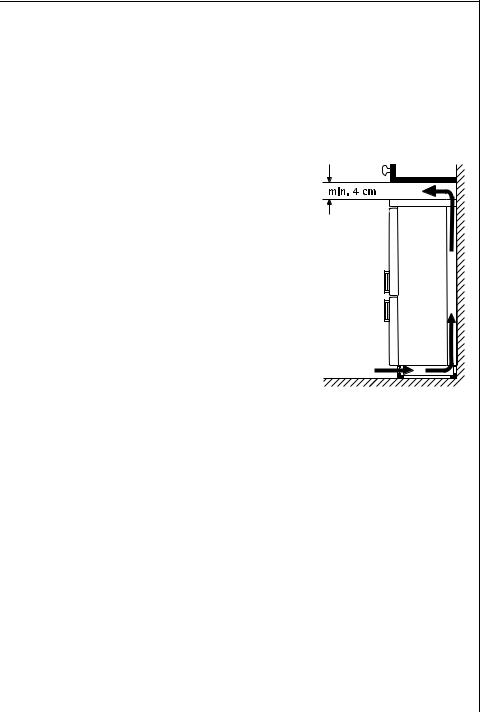AEG-Electrolux S3176KG8, S3166KG8 User Manual

SANTO
Combinaciones de refrigeradores y congeladores
Refrigerator/Freezer Combinations Combinações frigorífico/congelador
Instrucciones de servicio Operating Instructions Instruções de utilização

Dear customer,
Before placing your new refrigerator/freezer into operation please read these operating instructions carefully. They contain important information for safe use, for installation and for care of the appliance.
Please keep these operating instructions for future reference. Pass them on to possible new owners of the appliance.
These operating instructions are for use with several technically comparable models with varying accessories. Please observe the notes which apply to your model.
1 Notes which are important for your safety or for the proper functioning of the appliance are stressed with a warning triangle and/ or with signal words (Warning!, Caution!, Attention!). Please observe the following carefully.
0 This symbol guides you step by step in the operation of the appliance.
3 Supplementary information regarding operation and practical applications of the appliance appear after this symbol.
2 Tips and notes concerning economical and environmentally sound use of the appliance are marked with the cloverleaf.
Explanations of the technical terminology used in the operating instructions can be found at the end in the section "Technical Terminology".
The operating instructions contain instructions for the correction of possible malfunctions by the user in the section "What to do if...". If these instructions should not be sufficient, please contact your local Service Force Centre.
Printed on paper manufactured with environmentally sound processes.
he who thinks ecologically acts accordingly ...
32

Contents |
|
Safety . . . . . . . . . . . . . . . . . . . . . . . . . . . . . . . . . . . . . . . . . . . . . . . . . . . . . . . . . |
35 |
Environmental Information . . . . . . . . . . . . . . . . . . . . . . . . . . . . . . . . . . . . . . |
37 |
Packaging . . . . . . . . . . . . . . . . . . . . . . . . . . . . . . . . . . . . . . . . . . . . . . . . . . . . . . |
37 |
Old Appliances . . . . . . . . . . . . . . . . . . . . . . . . . . . . . . . . . . . . . . . . . . . . . . . . . . |
37 |
Appliance Transport . . . . . . . . . . . . . . . . . . . . . . . . . . . . . . . . . . . . . . . . . . . . |
38 |
Remove transport safeguard . . . . . . . . . . . . . . . . . . . . . . . . . . . . . . . . . . . . . |
38 |
Installation . . . . . . . . . . . . . . . . . . . . . . . . . . . . . . . . . . . . . . . . . . . . . . . . . . . . |
38 |
Installation Location . . . . . . . . . . . . . . . . . . . . . . . . . . . . . . . . . . . . . . . . . . . . . |
38 |
The refrigerator/freezer needs air . . . . . . . . . . . . . . . . . . . . . . . . . . . . . . . . . . |
39 |
Appliance Alignment . . . . . . . . . . . . . . . . . . . . . . . . . . . . . . . . . . . . . . . . . . . . . |
39 |
Electrical Connection . . . . . . . . . . . . . . . . . . . . . . . . . . . . . . . . . . . . . . . . . . . . |
39 |
Changing Over The Door Hinges . . . . . . . . . . . . . . . . . . . . . . . . . . . . . . . . . . |
40 |
Appliance Description . . . . . . . . . . . . . . . . . . . . . . . . . . . . . . . . . . . . . . . . . . . |
42 |
View of Appliance . . . . . . . . . . . . . . . . . . . . . . . . . . . . . . . . . . . . . . . . . . . . . . . |
42 |
Freezer tray . . . . . . . . . . . . . . . . . . . . . . . . . . . . . . . . . . . . . . . . . . . . . . . . . . . . . |
43 |
Control Panel . . . . . . . . . . . . . . . . . . . . . . . . . . . . . . . . . . . . . . . . . . . . . . . . . . . |
43 |
Buttons for Adjusting the Temperature . . . . . . . . . . . . . . . . . . . . . . . . . . . . . |
44 |
Temperature Displays . . . . . . . . . . . . . . . . . . . . . . . . . . . . . . . . . . . . . . . . . . . . |
44 |
Prior to Initial Start-Up . . . . . . . . . . . . . . . . . . . . . . . . . . . . . . . . . . . . . . . . . |
45 |
Initial Start-Up . . . . . . . . . . . . . . . . . . . . . . . . . . . . . . . . . . . . . . . . . . . . . . . . . 45
Temperature Adjustment . . . . . . . . . . . . . . . . . . . . . . . . . . . . . . . . . . . . . . . . 46
COOLMATIC/FROSTMATIC . . . . . . . . . . . . . . . . . . . . . . . . . . . . . . . . . . . . . . . 46 COOLMATIC . . . . . . . . . . . . . . . . . . . . . . . . . . . . . . . . . . . . . . . . . . . . . . . . . . . . 46 FROSTMATIC . . . . . . . . . . . . . . . . . . . . . . . . . . . . . . . . . . . . . . . . . . . . . . . . . . . . 47
Switching the Appliance Off . . . . . . . . . . . . . . . . . . . . . . . . . . . . . . . . . . . . . 47
Control and Information Systems . . . . . . . . . . . . . . . . . . . . . . . . . . . . . . . . . 48
"Open Door"-Warning . . . . . . . . . . . . . . . . . . . . . . . . . . . . . . . . . . . . . . . . . . . . 48
Temperature Warning . . . . . . . . . . . . . . . . . . . . . . . . . . . . . . . . . . . . . . . . . . . . 48
Function Errors . . . . . . . . . . . . . . . . . . . . . . . . . . . . . . . . . . . . . . . . . . . . . . . . . . 49
33

Contents
Interior Accessories . . . . . . . . . . . . . . . . . . . . . . . . . . . . . . . . . . . . . . . . . . . . . |
49 |
|
Storage Shelves . |
. . . . . . . . . . . . . . . . . . . . . . . . . . . . . . . . . . . . . . . . . . . . . . . . |
49 |
Variable Inner Door . . . . . . . . . . . . . . . . . . . . . . . . . . . . . . . . . . . . . . . . . . . . . . |
49 |
|
Dynamic Air Cooling System . . . . . . . . . . . . . . . . . . . . . . . . . . . . . . . . . . . . . . |
49 |
|
Proper Storage . |
. . . . . . . . . . . . . . . . . . . . . . . . . . . . . . . . . . . . . . . . . . . . . . . . |
50 |
Opening the Freezer Compartment Door . . . . . . . . . . . . . . . . . . . . . . . . . . |
50 |
|
Freezing . . . . . . . |
. . . . . . . . . . . . . . . . . . . . . . . . . . . . . . . . . . . . . . . . . . . . . . . . |
51 |
Frozen Storage . |
. . . . . . . . . . . . . . . . . . . . . . . . . . . . . . . . . . . . . . . . . . . . . . . . |
52 |
Preparation of Ice Cubes . . . . . . . . . . . . . . . . . . . . . . . . . . . . . . . . . . . . . . . . |
52 |
|
Storage Goods Symbols/Freezing Calendar . . . . . . . . . . . . . . . . . . . . . . . . . |
52 |
|
Defrosting . . . . . |
. . . . . . . . . . . . . . . . . . . . . . . . . . . . . . . . . . . . . . . . . . . . . . . . |
53 |
The refrigerator is defrosted automatically . . . . . . . . . . . . . . . . . . . . . . . . . . |
53 |
|
Freezer Compartment Defrosting . . . . . . . . . . . . . . . . . . . . . . . . . . . . . . . . . . . |
53 |
|
Cleaning and Maintenance . . . . . . . . . . . . . . . . . . . . . . . . . . . . . . . . . . . . . . |
54 |
|
Energy Saving Tips . . . . . . . . . . . . . . . . . . . . . . . . . . . . . . . . . . . . . . . . . . . . . . |
55 |
|
What to do if ... |
. . . . . . . . . . . . . . . . . . . . . . . . . . . . . . . . . . . . . . . . . . . . . . . . |
56 |
Correcting Malfunctions . . . . . . . . . . . . . . . . . . . . . . . . . . . . . . . . . . . . . . . . . . |
56 |
|
Replace light bulb |
. . . . . . . . . . . . . . . . . . . . . . . . . . . . . . . . . . . . . . . . . . . . . . . |
58 |
Noises during Operation . . . . . . . . . . . . . . . . . . . . . . . . . . . . . . . . . . . . . . . . . |
58 |
|
Regulations, Standards, Guidelines . . . . . . . . . . . . . . . . . . . . . . . . . . . . . . . |
59 |
|
Customer Service |
. . . . . . . . . . . . . . . . . . . . . . . . . . . . . . . . . . . . . . . . . . . . . . . |
59 |
34

1 Safety
The safety of our refrigerators/freezers is in accordance with recognised technological standards and appliance safety legislation. We nevertheless feel that it is important to acquaint you with the following safety guidelines:
Use for Intended Purpose
•The refrigerator/freezer is intended for household use. It is suited for the refrigeration, freezing and frozen storage of foods as well as the preparation of ice. If the appliance is used for purposes other than those intendet or used incorrectly, no liability can be accepted by the manufacturer for any damage that may be caused.
•Alterations or changes to the refrigerator/freezer are not permitted for reasons of safety.
•If you use the refrigerator/freezer in a commercial application or for purposes other than the refrigeration, freezing or frozen storage of foods, please observe all valid legal regulations for your application.
Prior to initial start-up
•Check the refrigerator/freezer for transport damage. Do not under any circumstances connect a damaged appliance! Please contact your supplier in the event of damage.
Refrigerant
The refrigerant isobutane (R600a) is contained within the refrigerant circuit of the appliance, a natural gas with a high level of environmental compatibility, which is nevertheless flammable.
•Warning - During transportation and installation of the appliance, be certain that none of the components of the refrigerant circuit become damaged.
•If the refrigerant circuit should become damaged:
–avoid open flames and sources of ignition;
–thoroughly ventilate the room in which the appliance is situated.
Safety for Children
•Packaging materials (e.g. films, styrofoam) can be dangerous for children. Danger of suffocation! Keep packaging materials away from children!
•Before disposing of old appliances make them inoperable. Remove plug from mains, sever the power cable, remove or destroy any snap or latch closures. This eliminates the danger that playing children lock themselves into the appliance (danger of suffocation!) or place themselves into other life-endangering situations.
35

Safety
•Children often do not recognise the dangers involved with household appliances. Please provide for the necessary supervision and do not allow children to play with the appliance!
Daily Operation
•Containers with flammable gases or fluids can develop leaks through contact with the cold. Danger of explosion! Do not store containers with flammable substances, such as aerosol cans, refill cartridges for cigarette lighters etc. in the refrigerator/freezer.
•Bottles and cans may not be placed in the freezer compartment. They can burst when the contents freeze - or even explode if the contents contain carbonic acid! Never place sodas, juices, beer, wine, champagne etc. into the freezer compartment. Exception: Spirits with high alcohol content may be stored in the freezer compartment.
•Do not place ice cream or ice cubes directly from the freezer compartment into the mouth. Very cold ice can freeze to the lips or tongue and cause injury.
•Never touch frozen goods with wet hands. Hands can freeze to the goods.
•Warning - Do not operate any electrical appliances in the appliance (e.g. electric ice cream makers, mixers etc.) unless they have been authorised by the manufacturer.
•Warning - In order not to impair the function of the appliance, never cover or obstruct the ventilation openings.
•Warning - Do not use any mechanical devices or other artificial means to speed up defrosting unless they are recommended by the manufacturer.
•Before cleaning the appliance switch off and remove the plug from the mains, or switch off or turn out the circuit breaker or fuse.
•Placing frozen goods on the top of the appliance can lead to the accumulation of condensate in the cavity of the storage tray through contact with the cold. Electronic components are housed within this cavity. If condensate should drip onto these components, the appliance could be damaged by a short circuit. For this reason do not place frozen goods on top of the appliance.
•When unplugging always pull the plug from the mains socket, do not pull on the cable.
In case of malfunction
•If a malfunction should occur at the appliance, refer first to the section "What to do if ..." in these operating instruction. If the instructions in this section are not sufficient, do not undertake any further work on your own.
36

•Refrigerators/feezers may only be repaired by trained personnel. Repairs carried out by untrained personnel can lead to substantial danger. Please contact your dealer or our customer service department for repairs.
Environmental Information
Packaging
All transit packaging materials are environmentally compatible and can be reused. Wood is un-treated. The plastics can be recycled and are identified as follows:
>PE< for polyethylene, e.g. the outer covering and the bags in the interior.
>PS< for polystyrene foam, e.g. the pads, which are pure hydrocarbon compounds and can be recycled.
The carton parts are made from recycled paper. Please dispose of the packaging with due care for the environment.
Old Appliances
For environmental reasons, refrigeration appliances must be disposed of properly. This applies to your old appliance, and - at the end of its service life - for your new appliance as well.
1 Warning! Before disposing of old appliances make them inoperable. Remove plug from mains, sever the power cable, remove or destroy any snap or latch closures. This eliminates the danger that playing children lock themselves into the appliance (danger of suffocation!) or place themselves into other life-endangering situations.
Disposal:
•The appliance may not be disposed of with domestic waste or bulky refuse.
•The refrigerant circuit, especially the heat exchanger at the back of the appliance, may not be damaged.
•Information concerning collection schedules or locations can be obtained from the local disposal authorities or town hall.
37

Appliance Transport
Two persons are required for transport of the appliance.
0In order to push the appliance into its final position, press carefully at the top of the upper door and tip the appliance back slightly. The weight is then transferred to the back wheels and the appliance can be easily pushed.
Remove transport safeguard
The appliance as well as interior accessory parts are safeguarded for transport.
0 Remove all tape and pads from the interior of the appliance.
3 Tape remnants can be removed with white spirit.
Installation
Installation Location
The appliance should be set up in a well ventilated, dry room.
Energy use and efficient performance of the appliance is affected by the ambient temperature.
The appliance should therefore
–not be exposed to direct sunlight;
–not be installed next to radiators, cookers or other sources of heat;
–only be installed at a location whose ambient temperature corresponds to the climate classification, for which the appliance is designed.
The climate classification can be found on the rating plate, which is located at the left on the inside of the appliance.
The following table shows which ambient temperature is correct for each climate classification:
Climate classification |
for an ambient temperature of |
SN |
+10 to +32 °C |
N |
+16 to +32 °C |
ST |
+18 to +38 °C |
T |
+18 to +43 °C |
|
|
38

Installation
If installation next to a source of heat is unavoidable, the following minimum clearances must be maintained at the sides of the appliance:
–for electric cookers 3 cm;
–for oil and coal fired ranges 30 cm.
If these clearances cannot be maintained a heat insulating pad is required between the cooker and the refrigeration appliance.
The refrigerator/freezer needs air
Air is fed under the door through the vent slots in the base and is exhausted upwards along the back wall. To ensure proper air circulation never cover or alter the vent openings.
Attention! If the appliance is installed under, for example, a hanging cabinet, a clearance of at least 4 cm between the top of the appliance and the cabinet above it must be maintained.
Appliance Alignment
0The appliance must have a solid, level footing. Please compensate for unevenness in the floor by turning the two adjustable feet at the front in or out.
Electrical Connection
A properly installed socket outlet with earthing contact is required for electrical connection. Electrical fuse protection must be of at least 10 ampere.
If the outlet socket is no longer accessible after installation of the appliance, appropriate measures must be taken during electrical installation to assure that the appliance can be disconnected from the mains (e.g. fuse, circuit breaker, non-operate current safety-switch or the like, with a contact opening of at least 3 mm).
0Before initial start-up, refer to the appliance rating plate to ascertain if supply voltage and current values correspond with those of the mains at the installation location.
39
